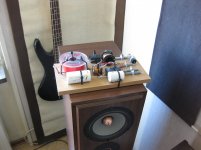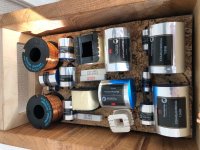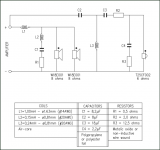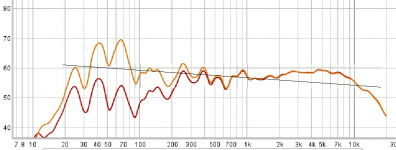You're getting there, but slow down for a moment. There's more to learn.
- Use parametric filters, as REW simulates. Those graphic EQs are not doing the same job.
- Using lots of gain to push up notches means lots of power used on something that will probably change frequency as you move around the room. There's an art to knowing which things can be fixed with EQ. Room cancellations cannot.
- EQ APO says you've got a peak gain of 19dB. Use the "Preamp" to reduce gain by 19dB so you're not going to get digital clipping.
- You've still got that rise in the kHz range.
If you like, post up the measurement file and I'll post up some EQ settings.
Chris
PS - Yes, you'll probably need to change the crossover at some point. For now, let's get you comfortable with measuring things, which frequency range sounds like what, etc.
- Use parametric filters, as REW simulates. Those graphic EQs are not doing the same job.
- Using lots of gain to push up notches means lots of power used on something that will probably change frequency as you move around the room. There's an art to knowing which things can be fixed with EQ. Room cancellations cannot.
- EQ APO says you've got a peak gain of 19dB. Use the "Preamp" to reduce gain by 19dB so you're not going to get digital clipping.
- You've still got that rise in the kHz range.
If you like, post up the measurement file and I'll post up some EQ settings.
Chris
PS - Yes, you'll probably need to change the crossover at some point. For now, let's get you comfortable with measuring things, which frequency range sounds like what, etc.
I think these are the files you need:
Listening position = before running any equalizer effects
List. posn. EQ lift mid 2 = after my second iteration of equalizer effects.
Listening position = before running any equalizer effects
List. posn. EQ lift mid 2 = after my second iteration of equalizer effects.
The other thing that I should mention is that I'm keen to keep very strong bass which is my personal preference and it seems to works well with all the hard surfaces in my room.
Try this:
60Hz, -15dB, Q=0.7
3800Hz, -6dB, Q=1
1kHz, +2dB, Q=1
You'll need to drop the overall gain by a couple of dB, too.
The 180Hz dip particularly will move in frequency or disappear entirely depending on the mic position, so I wouldn't try to EQ that back in.
I hear you about preferring a strong LF response. I find it's more down to what you're used to, but if you want extra bass, then you can reduce the cut on the 60Hz filter. I'd suggest running with those settings a while to get used to an approx. flat response, and then tweak to get things where you want them.
Chris
60Hz, -15dB, Q=0.7
3800Hz, -6dB, Q=1
1kHz, +2dB, Q=1
You'll need to drop the overall gain by a couple of dB, too.
The 180Hz dip particularly will move in frequency or disappear entirely depending on the mic position, so I wouldn't try to EQ that back in.
I hear you about preferring a strong LF response. I find it's more down to what you're used to, but if you want extra bass, then you can reduce the cut on the 60Hz filter. I'd suggest running with those settings a while to get used to an approx. flat response, and then tweak to get things where you want them.
Chris
How do I represent the different Q numbers in APO? At the moment, I've put your suggested figures in above, but not sure if there is some way to automatically load the REW filters into APO?
There's no automatic way of doing it as far as I know.
On EQ APO, click the green + to add a new filter. Parametric filter > Peaking filter
That'll get you the parametric filters that I've mentioned earlier. IMO, they're much more useful than graphic EQs.
Remember, you'll also need to add a "preamp" and reduce the gain by 2dB with the settings I've given above.
Chris
Chris
On EQ APO, click the green + to add a new filter. Parametric filter > Peaking filter
That'll get you the parametric filters that I've mentioned earlier. IMO, they're much more useful than graphic EQs.
Remember, you'll also need to add a "preamp" and reduce the gain by 2dB with the settings I've given above.
Chris
Chris
Ok, I've spent a few days listening and playing around with various settings and have reached the following conclusions.
Firstly, my listening preferences are definitely aligned to how the speakers currently work without EQ settings i.e. lots of low range bass and an increased high end. Thinking back, that's how I used to have my equalizer set on my old Kenwood hifi many many moons ago.
Having applied the EQ settings that you recommended, the reduction at 60Hz totally eliminates all bass everywhere in the room. I wonder whether this is some feature of the room perhaps? That's also the problem that I've had with most other speakers that I've used in this room over the last few years. I tired playing with the gain but found the best sound personally for me is not to apply a filter here.
The other two filters work well, but I changed the 3800kHz gain to -2dB and found that sounded best. I appreciate that I'm moving away from achieving a flat response but it does sound good!!
What is the next step?
Firstly, my listening preferences are definitely aligned to how the speakers currently work without EQ settings i.e. lots of low range bass and an increased high end. Thinking back, that's how I used to have my equalizer set on my old Kenwood hifi many many moons ago.
Having applied the EQ settings that you recommended, the reduction at 60Hz totally eliminates all bass everywhere in the room. I wonder whether this is some feature of the room perhaps? That's also the problem that I've had with most other speakers that I've used in this room over the last few years. I tired playing with the gain but found the best sound personally for me is not to apply a filter here.
The other two filters work well, but I changed the 3800kHz gain to -2dB and found that sounded best. I appreciate that I'm moving away from achieving a flat response but it does sound good!!
What is the next step?
Question about the LF filter: how long did you listen for? -15dB Q=0.7 is a large tonal shift, and it'll take a while for your ears/brain to adjust. Do you have any other references?
We often perceive louder = better, so I'm not particularly surprised you've backed off the attenuation in the mid-high range.
Paying attention to the vocal quality (which was the initial complaint IIRC), how does your perception of the problem change as you adjust the EQ?
Next step is to modify the crossover to reduce the 3.8kHz level by 2dB. Should be straightforward, if that's the way you want to go.
Chris
We often perceive louder = better, so I'm not particularly surprised you've backed off the attenuation in the mid-high range.
Paying attention to the vocal quality (which was the initial complaint IIRC), how does your perception of the problem change as you adjust the EQ?
Next step is to modify the crossover to reduce the 3.8kHz level by 2dB. Should be straightforward, if that's the way you want to go.
Chris
I listened for quite a while over a few days and also asked other people for their opinion without telling them what I was changing, all of whom much preferred the 'enhanced' bass. I took the attached measurements, red showing all 3 EQ settings applied, ie:
Preamp -2dB
60Hz, -15dB, Q=0.7
3800Hz, -2dB, Q=1
1kHz, +2dB, Q=1
and orange as above but without the 60Hz adjustment.
With regard to the vocals, the 1kHz adjustment has done the trick and the 3800kHz has made me realize that the highs were too high, with this adjustment it balances nicely.
Preamp -2dB
60Hz, -15dB, Q=0.7
3800Hz, -2dB, Q=1
1kHz, +2dB, Q=1
and orange as above but without the 60Hz adjustment.
With regard to the vocals, the 1kHz adjustment has done the trick and the 3800kHz has made me realize that the highs were too high, with this adjustment it balances nicely.
Attachments
I listened for quite a while over a few days and also asked other people for their opinion without telling them what I was changing, all of whom much preferred the 'enhanced' bass.
Not surprised, referenced to 1 kHz this BW needs a good 12+ dB boost to sound tonally flat.
GM
GM, I would expect a flat response to sound "tonally flat". Are you referring to the equal loudness contours..?
Yeah, that does look like too much LF attenuation. Might be worth trying -9dB, Q=1.
Glad the mid-high range is suiting you better now.
Chris
I listened for quite a while over a few days and also asked other people for their opinion without telling them what I was changing, all of whom much preferred the 'enhanced' bass. I took the attached measurements, red showing all 3 EQ settings applied, ie:
Preamp -2dB
60Hz, -15dB, Q=0.7
3800Hz, -2dB, Q=1
1kHz, +2dB, Q=1
and orange as above but without the 60Hz adjustment.
With regard to the vocals, the 1kHz adjustment has done the trick and the 3800kHz has made me realize that the highs were too high, with this adjustment it balances nicely.
Yeah, that does look like too much LF attenuation. Might be worth trying -9dB, Q=1.
Glad the mid-high range is suiting you better now.
Chris
Hello Viper_User,
Yes they are good, even though they've had a lot of criticism over the years on this forum by people who know a lot more than I do. I must say that your crossover is much simpler than my current one. I got mine from this forum which was developed about 2010ish from memory.
And they are getting better still thanks to all the help on this forum, especially from Chris661 who has been a great help.
Chris,
After spending more time listening, my listening preference hasn't changed with regard to leaving the LF where they are. It just seems to work really well in the room and I can also feel the LF through the chair which for me adds to the effect.
I would definitely like to apply the other mods that you suggested but slightly modified to the following:
3800Hz, -2dB, Q=1
1kHz, +2dB, Q=1
How do I go about this and how does the preamp adjustment fit into all of this?!
Thanks
Yes they are good, even though they've had a lot of criticism over the years on this forum by people who know a lot more than I do. I must say that your crossover is much simpler than my current one. I got mine from this forum which was developed about 2010ish from memory.
And they are getting better still thanks to all the help on this forum, especially from Chris661 who has been a great help.
Chris,
After spending more time listening, my listening preference hasn't changed with regard to leaving the LF where they are. It just seems to work really well in the room and I can also feel the LF through the chair which for me adds to the effect.
I would definitely like to apply the other mods that you suggested but slightly modified to the following:
3800Hz, -2dB, Q=1
1kHz, +2dB, Q=1
How do I go about this and how does the preamp adjustment fit into all of this?!
Thanks
Forgot to attach a photo of my crossover so you can compare...
That's intense sir! 😀
I did not do any tweaks, I bought the filter used and ready. The viring was as below.
Attachments
Last edited:
Chris,
After spending more time listening, my listening preference hasn't changed with regard to leaving the LF where they are. It just seems to work really well in the room and I can also feel the LF through the chair which for me adds to the effect.
I would definitely like to apply the other mods that you suggested but slightly modified to the following:
3800Hz, -2dB, Q=1
1kHz, +2dB, Q=1
How do I go about this and how does the preamp adjustment fit into all of this?!
Thanks
Fair enough. We all like different things, and if that's what makes you happy, then more power to you.
I like my system to be flat overall, and I appreciate you trying it that way.
The "preamp" control is to make sure you don't encounter digital clipping. If you boost, the curve turns red where it sticks up above 0dBFS. That means if there's a high-level signal there in the music, it will be clipped in the digital domain as the boost is trying to make the signal larger than is possible. By bringing the overall level down to match, the maximum signal level will be 0dBFS. ie, the maximum digital level without clipping.
What you need to do now is alter the crossover.
The 3.8kHz bit will probably be easy - a 3-component notch filter on the tweeter (before the HPF) will do that just fine.
The 1kHz bit will be more difficult. Reducing the value of the woofer inductor might help, but phase alignment with the tweeter might suffer. More components could be required.
To do it properly, you'll need measurements (impedance and frequency response) of the LF and HF sections without any crossover components (be careful with the tweeters - they don't like bass!) and we can design a crossover from scratch.
The new crossover can only be as good as the new measurements, so it might well be worth dragging them outside.
Chris
Chris,
I'm having trouble measuring the impedance. I get an error message saying clipping detected, followed by a low signal warning followed by a "12 sample timing offset - discard the results" warning. I've not changed any of the settings, not sure if I need to calibrate anything or if I need to adjust the sense resistor value which is set to 100?
I'm having trouble measuring the impedance. I get an error message saying clipping detected, followed by a low signal warning followed by a "12 sample timing offset - discard the results" warning. I've not changed any of the settings, not sure if I need to calibrate anything or if I need to adjust the sense resistor value which is set to 100?
- Home
- Loudspeakers
- Multi-Way
- Thor speaker – lots of help needed please!





